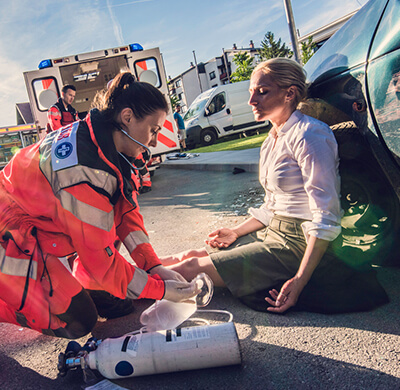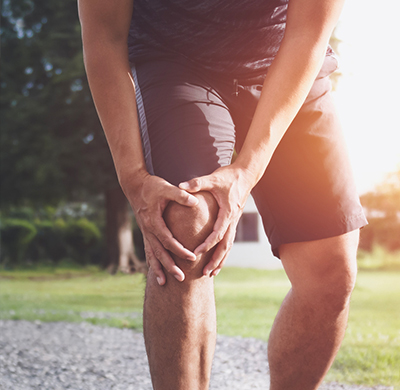Welcome to the Patient Education Library of Texas Medical Institute
Knee Arthroscopy
Click on the white PLAY button below to start video.
The knee is the largest joint in our body. It is one of the most easily injured joints. Our knees are exposed and vulnerable to sport or work injuries. Knee problems can also occur from disease, aging, or “wear and tear.” Arthroscopic Knee Surgery, also called Arthroscopy, is the most accurate procedure to both diagnose and treat knee conditions.
Arthroscopy allows surgeons to see, diagnose, and treat problems inside the knee joint. Before arthroscopic surgery existed, surgeons made large incisions that affected the surrounding joint structures and tissues. They had to open the knee joint to see it and perform surgery. An arthroscopy requires small incisions and is guided by a small viewing instrument or "scope.” Arthroscopy is less invasive than traditional surgical methods. It has a decreased risk of infection and a shorter recovery period.
Read more about Knee Arthroscopy
Introduction
The knee is the largest joint in our body. It is one of the most easily injured joints. Our knees are exposed and vulnerable to sport or work injuries. Knee problems can also occur from disease, aging, or “wear and tear.” Arthroscopic Knee Surgery, also called Arthroscopy, is the most accurate procedure to both diagnose and treat knee conditions.Arthroscopy allows surgeons to see, diagnose, and treat problems inside the knee joint. Before arthroscopic surgery existed, surgeons made large incisions that affected the surrounding joint structures and tissues. They had to open the knee joint to see it and perform surgery. An arthroscopy requires small incisions and is guided by a small viewing instrument or "scope.” Arthroscopy is less invasive than traditional surgical methods. It has a decreased risk of infection and a shorter recovery period.

Anatomy
The knee is one of the more complex joints in our body. Our knee is composed of three bones. The Femur, or thighbone, is positioned on top of the Tibia, or larger leg bone. The Patella, or kneecap, glides in a groove on the end of the femur. Large muscle groups in the thigh give the knee strength and stability.Four ligaments connect our knee bones together. The ligaments are strong tissues that provide stability and allow motion. The Medial Collateral Ligament is located on the inner side of our knee. The Lateral Collateral Ligament is at the outer side of our knee. These two ligaments help the joint to resist side to side stress and maintain positioning.
The Anterior Cruciate Ligament and the Posterior Cruciate Ligament cross inside of the knee joint. These two ligaments help to keep the joint aligned. They resist excessive forward and backward forces and prohibit displacement of the bones. They also produce and control rotation of the tibia. We rotate our tibia when we turn our leg outward to push off the ground with our foot. We use this motion to push off from the side when skate, run, or move our body to get into a car.
Two cartilage disks, called Menisci, are located on the end of the tibia. The cartilage forms a smooth surface and allows our bones to glide easily during motion. The menisci also act as a shock absorber when we walk or run.
A smooth tissue capsule covers the bones in our knee joint. A thin synovial membrane lines the capsule. The synovium secretes a thick liquid called synovial fluid. The synovial fluid acts as a cushion and lubricant between the joints, allowing us to perform smooth and painless motions.
Causes
Knee problems can occur from injury, disease, aging, or “wear and tear.” Any of the knee ligaments may be torn by an injury, especially during sports. The Medial Collateral Ligament most frequently tears during football, basketball, and volleyball. The Anterior and Posterior Cruciate Ligaments are frequently injured during football.The menisci are a common location of injury and disease. Meniscal injury usually occurs when the femur rotates suddenly and forcefully, while the tibia remains in a fixed position. The torque can cause the menisci to tear or fragment and become loose. This type of injury can occur in football when a player is tackled or clipped from the side.
Overuse and “wear and tear” can cause the ligaments and synovium to become inflamed. They may swell and feel painful. Inflammation of the synovial membrane can occur with rheumatoid or gouty arthritis, as can bone deterioration. The knee bones can be fractured or broken during an injury. The patella may come out of its normal alignment and become unstable. The patella is commonly fractured from falls directly onto the knee.
Symptoms
Swelling and continuous pain are hallmark symptoms of knee injuries. Your knee may feel like it has a catch in it when you move it. It may suddenly give way as you stand or walk, causing you to fall.Diagnosis
A doctor can evaluate your knee by gathering your medical history, performing a physical examination, and viewing medical images. Your doctor will ask you about your symptoms and what happened if you were injured. Your doctor will examine your knee and your leg alignment. You will be asked to perform simple movements to help your doctor assess your muscle strength, joint motion, and stability.Your physician will order X-rays to see the condition of the bones in your knee and to identify arthritis. Sometimes a fracture or soft tissue injury does not show up on an X-ray. In this case, your doctor may order a Magnetic Resonance Imaging (MRI) scan. A MRI scan will provide a very detailed view of your knee structure. Like the X-ray, the MRI does not hurt and you need to remain very still while the images are taken.
Treatment
Most knee conditions can be treated with non-surgical methods. This includes medication, knee bracing, and physical rehabilitation. Arthroscopy is recommended when such treatments have provided minimal or no improvement of your symptoms. Arthroscopy is commonly used to reconstruct ligaments and remove or repair torn meniscal cartilage, synovium, or bone fragments. Your doctor will discuss your examination results and help you decide on your course of treatment.Surgery
Almost all arthroscopic knee surgeries are performed as outpatient procedures. You will be asked to complete a physical examination prior to your surgery. You may be sedated for the surgery or receive a local or regional anesthetic. Local anesthesia will numb your knee area, and regional anesthesia will numb you below the waist. General anesthesia may also be used.Before the operation, your surgeon will elevate your leg and apply a tourniquet, an inflatable band. This will reduce the blood flow to your knee during the procedure.
Your surgeon will make one or more small incisions, about ¼” to ½” in length, near your joint. Your surgeon will fill the joint space with a sterile saline (salt-water) solution. Expansion of the space allows your surgeon to have a better view of your joint structures. Your surgeon will insert the arthroscope and may reposition it to see your joint from different angles.
If you are having surgical treatment, your surgeon may make additional small incisions and use other slender surgical instruments.
When your procedure is completed, your surgeon may inject your joint with medication to reduce pain and inflammation. Because the incisions are so small, they will require just a few stitches or Steri-Strips. Your surgeon will cover them with a bandage.
Recovery
After surgery, you will be instructed to elevate your leg and apply ice to your joint to help reduce pain and swelling. Your surgeon may restrict your activity and may recommend that you wear a knee brace for a short period of time following your procedure. You will need to use crutches, a walker, or a cane to help you walk at first.Your surgeon will instruct you regarding how much weight to put on your leg, depending on your procedure. Physical therapy is recommended to help you move and strengthen your knee.
Your recovery time will depend on the extent of your condition and the amount of surgery that you had. Your surgeon will let you know what to expect. It usually takes a joint several weeks to several months fully recover.
Your doctor may set temporary or permanent physical restrictions for you depending on your type of injury. Your injury itself may restrict you form performing certain activities. For instance, if part of your menisci needed to be removed, you may be restricted from performing running activities or lifting large amounts of weight.
Some individuals with certain ligament injuries will need to wear a knee brace for walking. Return to intense physical activity should only be done under the direction of your surgeon.
It may be helpful to avoid significant weight bearing impact and twisting movements at the knee. Restrictions are very individualized and your surgeon will discuss them with you.
Overall, arthroscopic knee surgery requires a shorter length of time for recovery than open joint surgery. It also has a reduced risk of infection and causes minimal pain and stiffness because only small incisions are used and less surrounding tissue is affected or exposed. Most individuals achieve good results.
Prevention
Once you have injured your knee, it is important to avoid another knee injury. Talk to your surgeon about your activity precautions. It can be helpful to exercise to keep the muscles around your knee joint strong.
Copyright © - iHealthSpot Interactive - www.iHealthSpot.com
This information is intended for educational and informational purposes only. It should not be used in place of an individual consultation or examination or replace the advice of your health care professional and should not be relied upon to determine diagnosis or course of treatment.
The iHealthSpot patient education library was written collaboratively by the iHealthSpot editorial team which includes Senior Medical Authors Dr. Mary Car-Blanchard, OTD/OTR/L and Valerie K. Clark, and the following editorial advisors: Steve Meadows, MD, Ernie F. Soto, DDS, Ronald J. Glatzer, MD, Jonathan Rosenberg, MD, Christopher M. Nolte, MD, David Applebaum, MD, Jonathan M. Tarrash, MD, and Paula Soto, RN/BSN. This content complies with the HONcode standard for trustworthy health information. The library commenced development on September 1, 2005 with the latest update/addition on February 16, 2022. For information on iHealthSpot’s other services including medical website design, visit www.iHealthSpot.com.






